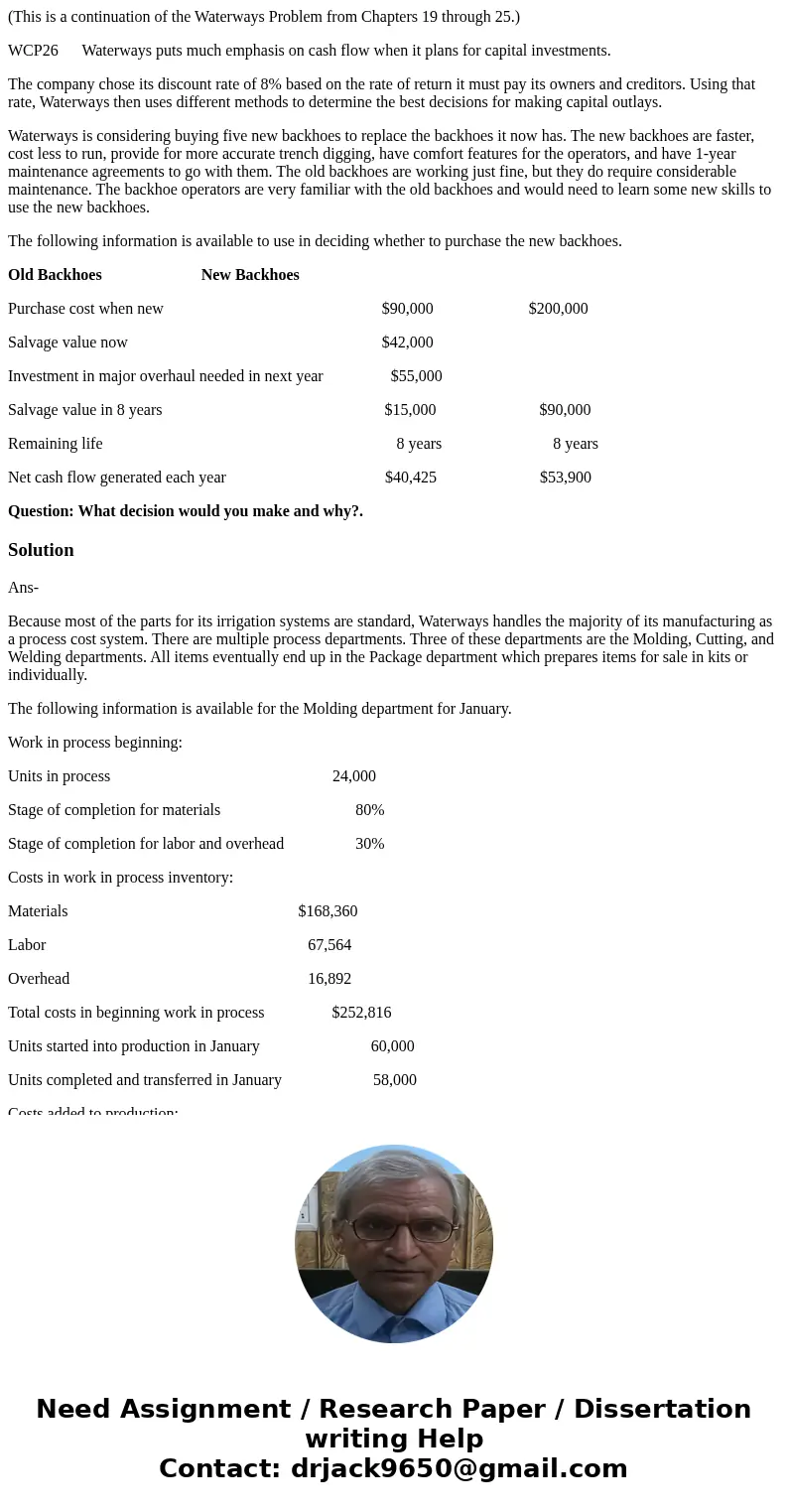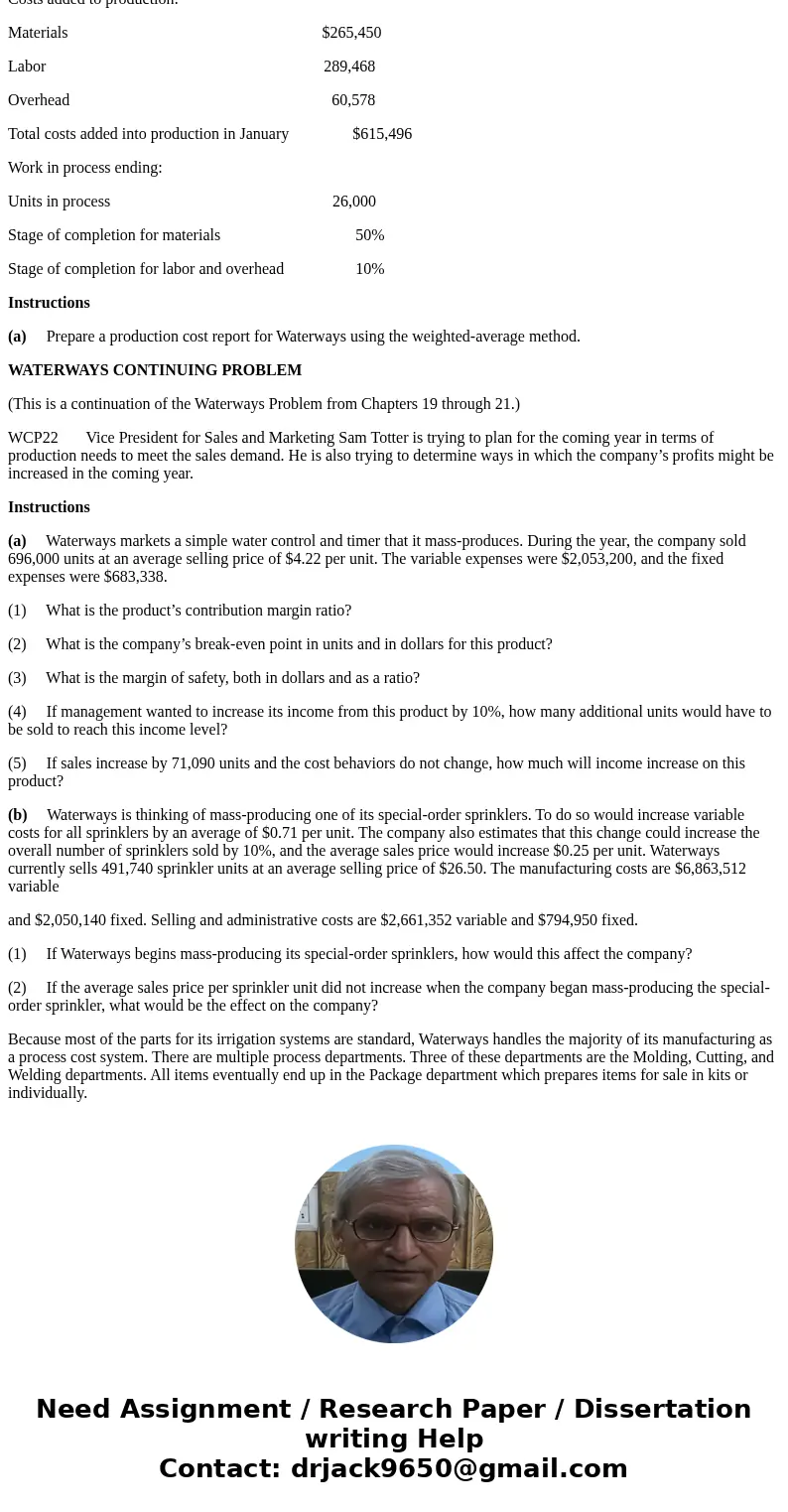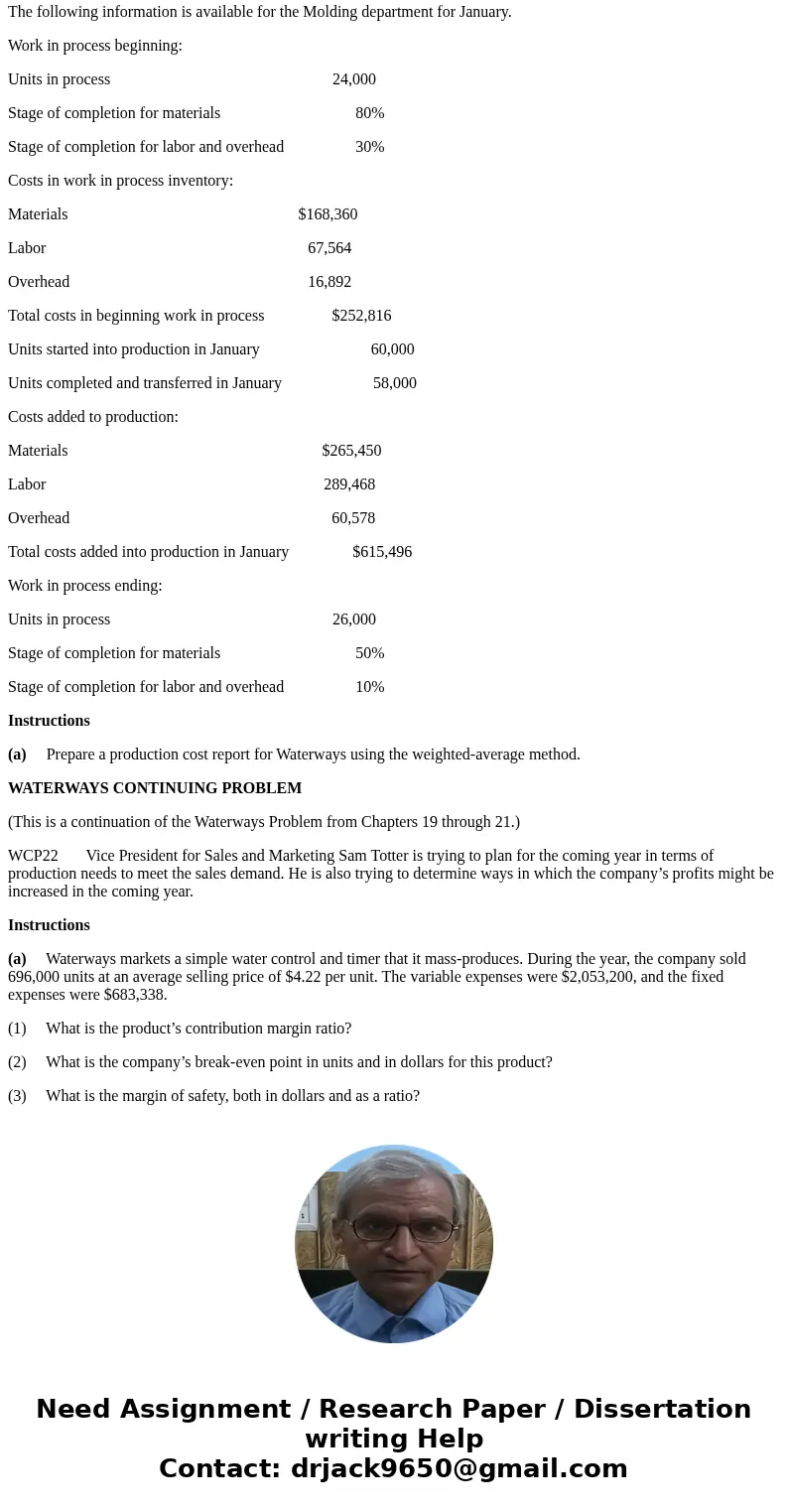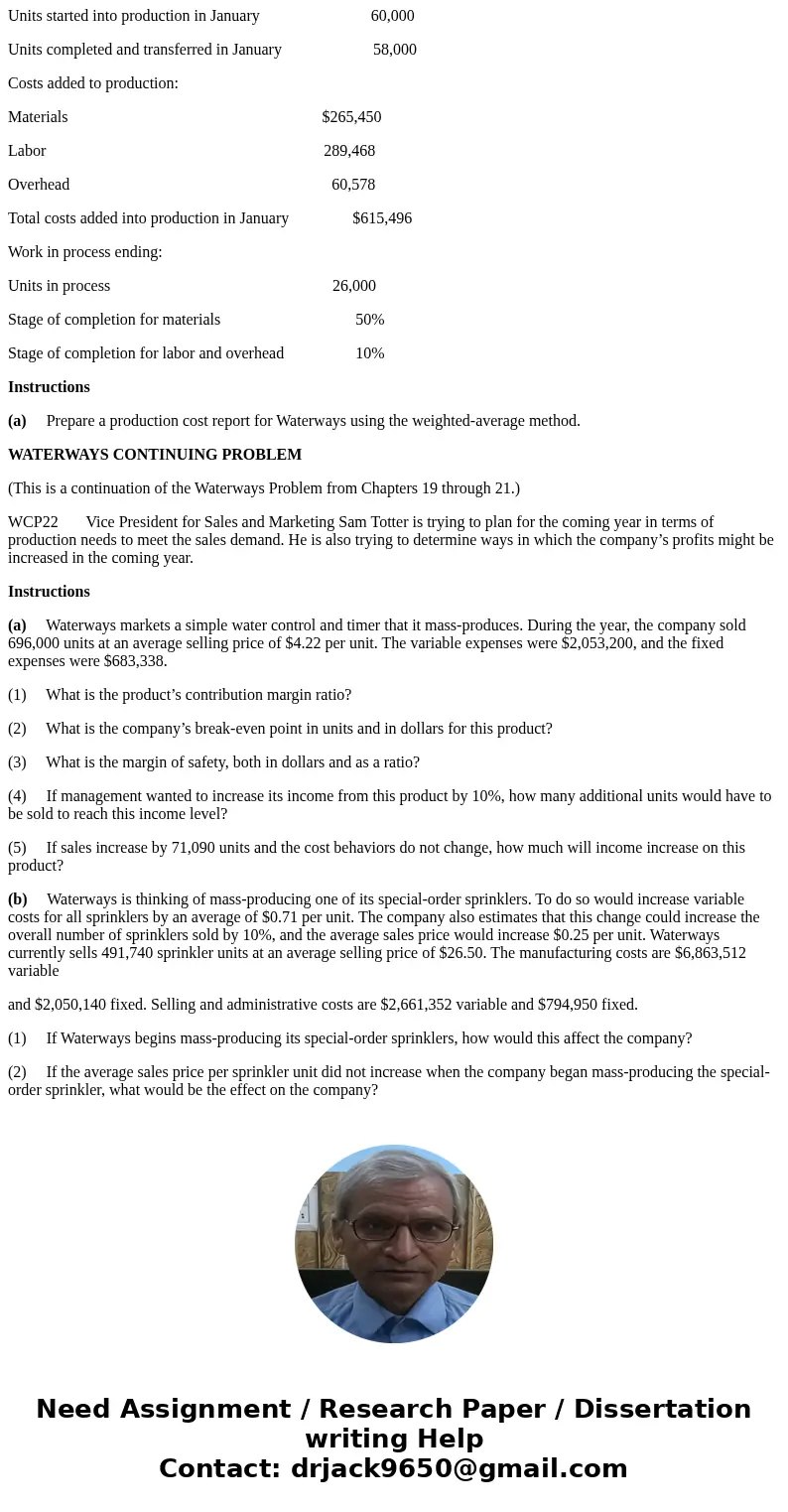This is a continuation of the Waterways Problem from Chapter
(This is a continuation of the Waterways Problem from Chapters 19 through 25.)
WCP26 Waterways puts much emphasis on cash flow when it plans for capital investments.
The company chose its discount rate of 8% based on the rate of return it must pay its owners and creditors. Using that rate, Waterways then uses different methods to determine the best decisions for making capital outlays.
Waterways is considering buying five new backhoes to replace the backhoes it now has. The new backhoes are faster, cost less to run, provide for more accurate trench digging, have comfort features for the operators, and have 1-year maintenance agreements to go with them. The old backhoes are working just fine, but they do require considerable maintenance. The backhoe operators are very familiar with the old backhoes and would need to learn some new skills to use the new backhoes.
The following information is available to use in deciding whether to purchase the new backhoes.
Old Backhoes New Backhoes
Purchase cost when new $90,000 $200,000
Salvage value now $42,000
Investment in major overhaul needed in next year $55,000
Salvage value in 8 years $15,000 $90,000
Remaining life 8 years 8 years
Net cash flow generated each year $40,425 $53,900
Question: What decision would you make and why?.
Solution
Ans-
Because most of the parts for its irrigation systems are standard, Waterways handles the majority of its manufacturing as a process cost system. There are multiple process departments. Three of these departments are the Molding, Cutting, and Welding departments. All items eventually end up in the Package department which prepares items for sale in kits or individually.
The following information is available for the Molding department for January.
Work in process beginning:
Units in process 24,000
Stage of completion for materials 80%
Stage of completion for labor and overhead 30%
Costs in work in process inventory:
Materials $168,360
Labor 67,564
Overhead 16,892
Total costs in beginning work in process $252,816
Units started into production in January 60,000
Units completed and transferred in January 58,000
Costs added to production:
Materials $265,450
Labor 289,468
Overhead 60,578
Total costs added into production in January $615,496
Work in process ending:
Units in process 26,000
Stage of completion for materials 50%
Stage of completion for labor and overhead 10%
Instructions
(a) Prepare a production cost report for Waterways using the weighted-average method.
WATERWAYS CONTINUING PROBLEM
(This is a continuation of the Waterways Problem from Chapters 19 through 21.)
WCP22 Vice President for Sales and Marketing Sam Totter is trying to plan for the coming year in terms of production needs to meet the sales demand. He is also trying to determine ways in which the company’s profits might be increased in the coming year.
Instructions
(a) Waterways markets a simple water control and timer that it mass-produces. During the year, the company sold 696,000 units at an average selling price of $4.22 per unit. The variable expenses were $2,053,200, and the fixed expenses were $683,338.
(1) What is the product’s contribution margin ratio?
(2) What is the company’s break-even point in units and in dollars for this product?
(3) What is the margin of safety, both in dollars and as a ratio?
(4) If management wanted to increase its income from this product by 10%, how many additional units would have to be sold to reach this income level?
(5) If sales increase by 71,090 units and the cost behaviors do not change, how much will income increase on this product?
(b) Waterways is thinking of mass-producing one of its special-order sprinklers. To do so would increase variable costs for all sprinklers by an average of $0.71 per unit. The company also estimates that this change could increase the overall number of sprinklers sold by 10%, and the average sales price would increase $0.25 per unit. Waterways currently sells 491,740 sprinkler units at an average selling price of $26.50. The manufacturing costs are $6,863,512 variable
and $2,050,140 fixed. Selling and administrative costs are $2,661,352 variable and $794,950 fixed.
(1) If Waterways begins mass-producing its special-order sprinklers, how would this affect the company?
(2) If the average sales price per sprinkler unit did not increase when the company began mass-producing the special-order sprinkler, what would be the effect on the company?
Because most of the parts for its irrigation systems are standard, Waterways handles the majority of its manufacturing as a process cost system. There are multiple process departments. Three of these departments are the Molding, Cutting, and Welding departments. All items eventually end up in the Package department which prepares items for sale in kits or individually.
The following information is available for the Molding department for January.
Work in process beginning:
Units in process 24,000
Stage of completion for materials 80%
Stage of completion for labor and overhead 30%
Costs in work in process inventory:
Materials $168,360
Labor 67,564
Overhead 16,892
Total costs in beginning work in process $252,816
Units started into production in January 60,000
Units completed and transferred in January 58,000
Costs added to production:
Materials $265,450
Labor 289,468
Overhead 60,578
Total costs added into production in January $615,496
Work in process ending:
Units in process 26,000
Stage of completion for materials 50%
Stage of completion for labor and overhead 10%
Instructions
(a) Prepare a production cost report for Waterways using the weighted-average method.
WATERWAYS CONTINUING PROBLEM
(This is a continuation of the Waterways Problem from Chapters 19 through 21.)
WCP22 Vice President for Sales and Marketing Sam Totter is trying to plan for the coming year in terms of production needs to meet the sales demand. He is also trying to determine ways in which the company’s profits might be increased in the coming year.
Instructions
(a) Waterways markets a simple water control and timer that it mass-produces. During the year, the company sold 696,000 units at an average selling price of $4.22 per unit. The variable expenses were $2,053,200, and the fixed expenses were $683,338.
(1) What is the product’s contribution margin ratio?
(2) What is the company’s break-even point in units and in dollars for this product?
(3) What is the margin of safety, both in dollars and as a ratio?
(4) If management wanted to increase its income from this product by 10%, how many additional units would have to be sold to reach this income level?
(5) If sales increase by 71,090 units and the cost behaviors do not change, how much will income increase on this product?
(b) Waterways is thinking of mass-producing one of its special-order sprinklers. To do so would increase variable costs for all sprinklers by an average of $0.71 per unit. The company also estimates that this change could increase the overall number of sprinklers sold by 10%, and the average sales price would increase $0.25 per unit. Waterways currently sells 491,740 sprinkler units at an average selling price of $26.50. The manufacturing costs are $6,863,512 variable
and $2,050,140 fixed. Selling and administrative costs are $2,661,352 variable and $794,950 fixed.
(1) If Waterways begins mass-producing its special-order sprinklers, how would this affect the company?
(2) If the average sales price per sprinkler unit did not increase when the company began mass-producing the special-order sprinkler, what would be the effect on the company?




 Homework Sourse
Homework Sourse